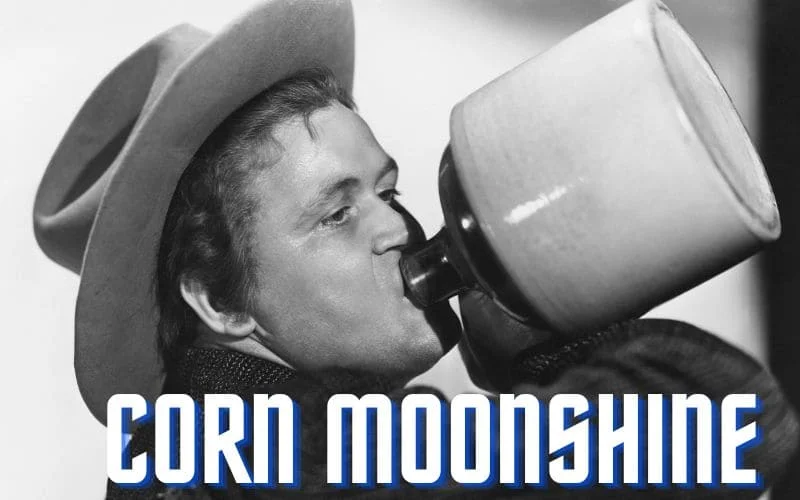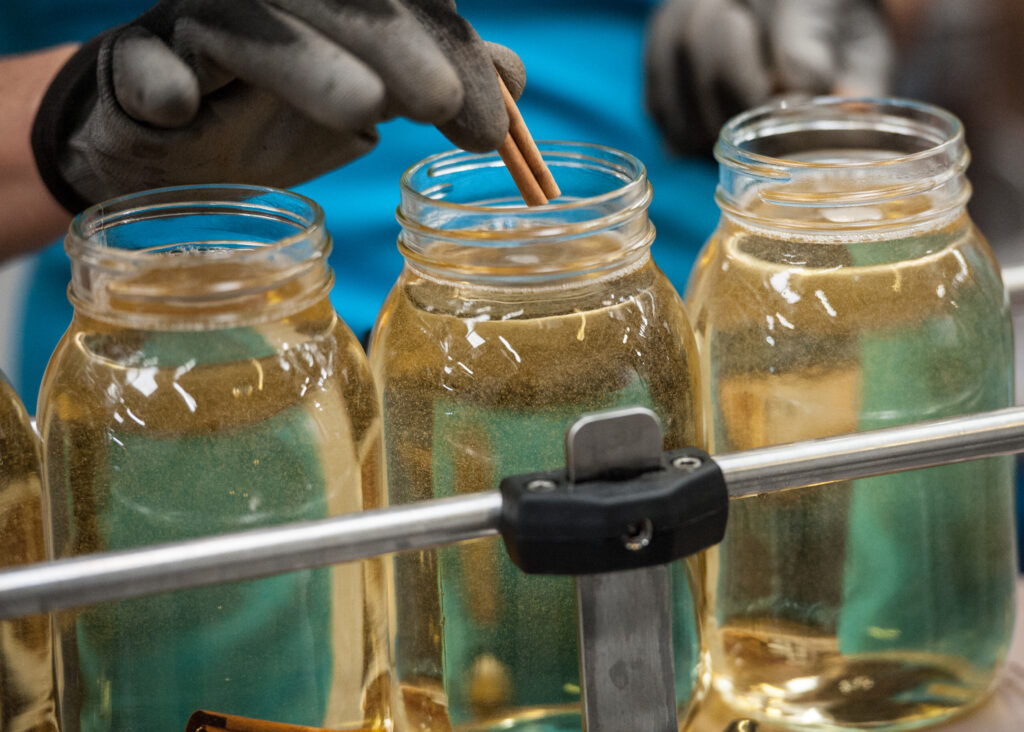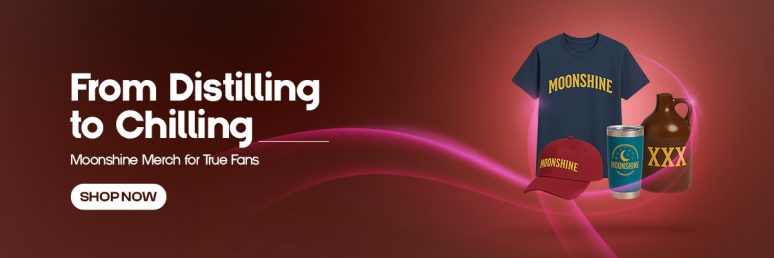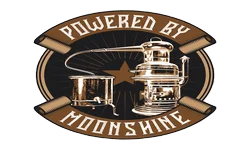Corn Moonshine: History, Secrets, and Facts Every Distiller Should Know

Key Takeaways
- Corn moonshine’s history stretches back to the early American frontier, where it became an essential economic product for farmers needing to transport their corn harvest in a more valuable form.
- Traditional moonshine is made from just four ingredients: corn, malted barley, water, and yeast, with the production process requiring precise temperature control and careful distillation.
- The term “moonshine” dates back to 15th-century England but gained its American association with illicit spirits during the late 18th century when distillers worked by moonlight to avoid detection.
- Prohibition (1920-1933) created the golden era of moonshining, transforming it from a regional practice to a nationwide underground industry.
- While home distilling remains illegal in the United States without proper permits, the first legal moonshine distillery opened in 2005, sparking a craft moonshine revolution that continues today.
The history of corn moonshine is written in copper stills and mason jars, hidden mountain hollows and midnight runs down country roads. For generations, this unaged corn whiskey has represented American ingenuity, rebellion, and tradition all bottled together in crystal-clear liquid that packs a legendary punch.
Every serious distiller should understand the historical roots of moonshining to truly appreciate the craft. While today’s legal distilleries produce “moonshine” under regulated conditions, the essence of what makes this spirit special comes from its colorful and sometimes dangerous past. Moonshine University continues this tradition by teaching modern distillers the techniques that have been passed down through generations, helping preserve this important piece of American cultural heritage.
The Untold Story of American Corn Moonshine

“100% Malted Corn MOONSHINE! + Testing …” from www.youtube.com and used with no modifications.
Corn moonshine emerged as a practical solution to an economic problem faced by early American settlers. In the frontier regions, particularly Appalachia, farmers produced corn in abundance but faced significant challenges getting their harvest to market. Roads were poor, and transportation costs high. Converting corn into whiskey created a product that was more valuable, easier to transport, and wouldn’t spoil—essentially turning food into currency.
“We didn’t call it ‘moonshine’ back in my grandfather’s day. It was just ‘the whiskey’ – something every farmer made to survive the winter when crops wouldn’t grow and money was scarce.” – Marvin “Popcorn” Sutton, legendary Appalachian moonshiner
This frontier necessity quickly developed into a cultural tradition and skilled craft. The techniques for distilling corn whiskey were brought to America primarily by Scots-Irish immigrants who settled in the Appalachian region. These settlers applied their old-world distilling knowledge to new-world ingredients, with corn replacing the barley and rye commonly used in European spirits. Learn more about the history of moonshine and its evolution in America.
The isolation of mountain communities allowed distilling traditions to flourish relatively undisturbed, creating regional variations and family recipes that were guarded as closely as any family heirloom. What began as economic necessity evolved into an art form that became deeply embedded in Appalachian culture, with distinctive still designs, mash recipes, and distilling techniques passed down through generations.
What Makes Corn Moonshine Different from Commercial Whiskey

“The Ultimate Guide to Corn Whiskey” from prestigehaus.com and used with no modifications.
The fundamental difference between traditional moonshine and commercial whiskey lies not in the ingredients but in the aging process—or lack thereof. While bourbon and other whiskeys gain their amber color and mellow flavor profile from years spent in charred oak barrels, moonshine goes straight from the still to the jar, preserving its raw, powerful character.
The Simple Four-Ingredient Recipe
Traditional corn moonshine follows a remarkably simple recipe that has remained largely unchanged for centuries. The classic formula requires just four basic ingredients: corn, sugar, water, and yeast. For those curious about the process, understanding how long mash can sit after fermenting is essential to achieving the best results.
- Ground corn (typically 80-85% of the grain bill)
- Malted barley (10-15%, providing essential enzymes for starch conversion)
- Water (preferably from a natural spring or well)
- Yeast (often traditional distiller’s yeast or sometimes wild yeast)
This simplicity is deceiving, however. The quality of each ingredient, the proportions used, the fermentation conditions, and most importantly, the skill of the distiller all contribute to the final product’s character. Master moonshiners could tell by sight, smell, and taste exactly when to make the critical “cuts” during distillation—separating the dangerous “heads,” valuable “hearts,” and unwanted “tails” of the run.
Why Clear vs. Amber: The Aging Factor
Moonshine’s crystal-clear appearance comes from its unaged nature. Straight from the still, all whiskey is clear—it’s only after spending time in charred oak barrels that whiskey develops its characteristic amber color and the vanilla, caramel, and oak flavors associated with aged spirits. Moonshine bypasses this aging process entirely, preserving the pure, unadulterated flavor of the fermented grain mash.
This unaged character gives moonshine its distinctive corn-forward flavor profile, often described as sweet and cereal-like with a notable alcohol presence. The absence of barrel aging also means moonshine delivers a more direct expression of the distiller’s skill and the quality of the ingredients. There’s nowhere to hide flaws in unaged spirit, making proper distilling technique absolutely critical.
Proof Points: Moonshine’s High Alcohol Content
Traditional moonshine was typically distilled to a much higher proof than commercial spirits, often reaching 150-170 proof (75-85% alcohol by volume). This high alcohol content served practical purposes: it preserved the spirit without refrigeration and provided more “bang for the buck” when selling to customers. Commercial moonshine today is usually bottled at lower proofs, typically 80-100 proof (40-50% ABV), to comply with regulations and appeal to modern palates. If you’re curious about whether moonshine gets more potent with age, we have the answers.
The high proof of traditional moonshine wasn’t just about potency—it was also a mark of the distiller’s skill. Achieving high alcohol concentrations required precise temperature control and multiple distillation runs in pot stills. The number of “runs” through the still often determined the final proof and purity, with triple-distilled moonshine being considered the gold standard among serious moonshiners.
From Outlaws to Artisans: Moonshine’s Colorful History

“Inside Moonshine – From Outlaw drink to …” from www.youtube.com and used with no modifications.
The story of moonshine in America is inseparable from the story of taxation and rebellion. What began as a common household practice became an underground economy when the federal government first placed a tax on distilled spirits in 1791, sparking the Whiskey Rebellion. This pattern of taxation and resistance would define moonshine culture for centuries to come.
15th Century Origins of the Term “Moonshine”
The term “moonshine” has roots that stretch back to 15th-century England, where it originally referred to any activity done by the light of the moon. By the late 18th century, English smugglers working at night to avoid customs officers were said to be working “by the moonshine.” When American distillers began working after dark to avoid tax collectors, the term naturally transferred to their illicit spirits.
Prohibition Era: When Moonshining Boomed
Prohibition (1920-1933) created the golden era of moonshining in America. When the 18th Amendment banned the production, transportation, and sale of alcoholic beverages nationwide, it inadvertently created a massive underground market. Rural moonshiners suddenly found themselves with an insatiable urban customer base willing to pay premium prices for illicit spirits. Production soared as thousands of hidden stills worked around the clock to meet demand. For those interested in the production process, understanding how much whiskey a 5-gallon still can make provides insight into the scale of operations during this era.
During these thirteen years, moonshining transformed from a regional Appalachian practice into a nationwide phenomenon. Sophisticated distribution networks emerged, connecting mountain distillers with speakeasies in cities hundreds of miles away. The quality of moonshine varied wildly during this period, from carefully crafted traditional recipes to hastily produced “sugar shine” made with cheaper ingredients to maximize profits. This era also saw the rise of notorious moonshiners who became folk heroes for outwitting federal agents.
The repeal of Prohibition in 1933 didn’t end moonshining—it simply returned it to its rural roots. In many isolated communities, particularly throughout the South, economic necessity and cultural tradition kept the practice alive despite its illegality. Tax-free moonshine remained significantly cheaper than legal, taxed spirits, ensuring a steady customer base for decades to come. For an interesting read on one of the most famous moonshiners, check out Popcorn Sutton’s moonshine legacy.
Southern Pride: North Carolina’s Deep Moonshine Roots
North Carolina stands as the historical epicenter of American moonshine culture. The state’s geography provided the perfect conditions: abundant corn crops, secluded mountain valleys ideal for hiding stills, and countless springs offering clean water essential for quality whiskey. By the early 20th century, western North Carolina was producing more illicit whiskey than any other region in America.
The moonshine tradition became so deeply embedded in North Carolina culture that local sheriffs often maintained an uneasy truce with distillers, focusing enforcement on outsiders or those who produced dangerous products. Many communities relied on moonshine income, with networks of lookouts, suppliers, and transporters all benefiting from the underground economy. This strong cultural connection explains why North Carolina is now home to many legal moonshine distilleries that proudly celebrate this heritage.
Moonshine and NASCAR: The Surprising Connection
Perhaps the most fascinating legacy of moonshine culture is its direct connection to the birth of NASCAR racing. The skilled drivers who transported moonshine—known as “runners” or “trippers”—modified their vehicles for speed and handling, outrunning federal agents on winding mountain roads at night. These same drivers began competing against each other on weekends, first on dirt tracks and later in organized races that evolved into NASCAR.
Junior Johnson, one of NASCAR’s earliest stars, began his driving career delivering his father’s moonshine throughout North Carolina. His intimate knowledge of high-speed driving under pressure translated perfectly to the racetrack. The specialized vehicles, driving techniques, and competitive spirit that defined early stock car racing all emerged directly from moonshine culture, creating a multibillion-dollar sports industry from the humble beginnings of corn whiskey deliveries.
The Legal Landscape of Moonshine Distilling

“How to Distill Whiskey and Moonshine” from www.whiskeystillpro.com and used with no modifications.
The legal status of moonshine has evolved dramatically over the past century, though significant restrictions remain. Understanding these legal boundaries is essential for anyone interested in distilling history or considering entering the craft spirits industry today. The distinction between illegal “moonshine” and legal “unaged whiskey” comes down to permits, taxes, and compliance with safety regulations.
Home Distilling vs. Commercial Production: What’s Legal?
Federal law in the United States maintains a clear prohibition against home distilling without proper permits. Unlike homebrewing beer or making wine for personal consumption, which became legal in 1978, producing distilled spirits at home remains illegal regardless of whether it’s for personal use or sale. The Bureau of Alcohol, Tobacco, Firearms and Explosives (ATF) requires various permits, including a Federal Distilled Spirits Permit, which typically requires a commercial facility and substantial fees.
The 2005 Turning Point: First Legal Moonshine Distillery
A watershed moment in moonshine history occurred in 2005 when Piedmont Distillers in North Carolina obtained federal approval to become the first legal moonshine distillery in the United States. Founded by Joe Michalek with the involvement of legendary moonshiner Junior Johnson, Piedmont’s “Midnight Moon” brand helped transform moonshine from an underground product to a legitimate category in the spirits industry.
This legal breakthrough opened the floodgates for a new generation of craft distillers who could now produce traditional moonshine recipes while complying with federal regulations. Within a decade, legal moonshine distilleries had opened in nearly every state, with particular concentrations in traditional moonshining regions like Tennessee, Kentucky, and the Carolinas. These distilleries often employed former illicit moonshiners as consultants, preserving authentic techniques while ensuring product safety.
Why Home Distilling Remains Illegal While Homebrewing Beer Is Allowed
The continued prohibition against home distilling stems from three primary concerns: safety hazards, potential tax evasion, and the historical association with organized crime. Distillation presents genuine fire and explosion risks if conducted improperly. Moreover, the government maintains that allowing untaxed spirits production would create enforcement challenges and revenue losses. Despite growing calls from hobbyists for a personal-use exemption similar to homebrewing, federal authorities have shown little interest in changing these regulations.
The Art and Science of Making Corn Moonshine

“The Smoothest Moonshine Mash Recipe You …” from stillntheclear.com and used with no modifications.
At its core, moonshine production follows the same basic principles used in all whiskey making: converting grain starches to sugars, fermenting those sugars into alcohol, and concentrating that alcohol through distillation. However, traditional moonshine methods developed distinct regional variations and specialized techniques that set them apart from commercial whiskey production. These methods were refined through generations of trial and error.
Choosing Your Corn: Field Corn vs. Alternatives
Traditional moonshiners didn’t use sweet corn from the garden but instead relied on field corn (dent corn) with its higher starch content. This starch-rich variety provided more fermentable sugars and ultimately higher alcohol yields. Modern craft distillers often experiment with heritage corn varieties or locally sourced options to create distinctive flavor profiles. Some contemporary producers even use blue corn, creating spirits with subtle nutty notes not found in traditional recipes.
The 3-Step Traditional Process
- Mashing: Grinding corn and cooking it with water to create a porridge-like mixture, then adding malted barley to convert starches to fermentable sugars
- Fermentation: Adding yeast to the cooled mash and allowing it to convert sugars to alcohol over 3-7 days, creating a beer-like liquid called “wash” or “beer” at 8-12% ABV
- Distillation: Heating the fermented mash in a still where alcohol (which boils at a lower temperature than water) vaporizes, then condensing these vapors back into liquid form at a much higher proof
Traditional moonshiners developed specialized terminology for each stage of production. The initial fermented liquid was called “beer,” though it bore little resemblance to drinking beer. The first distillation run produced “low wines” at about 40-50% alcohol. Many moonshiners performed a second or even third distillation to achieve higher proof and purity, with the final product often reaching 160 proof or higher.
The most critical skill in moonshine production was making proper “cuts”—separating the distillate into fractions. The first vapors to condense (the “foreshots” or “heads”) contain dangerous methanol and other volatile compounds and were discarded. The desirable middle portion (the “hearts”) contained the cleanest ethanol and best flavors. The final portion (the “tails”) contained fusel oils and water and was either discarded or saved for redistillation.
Experienced moonshiners made these cuts by smell, taste, and appearance, often using techniques passed down through generations. The ability to make precise cuts without modern equipment or alcohol meters demonstrates the remarkable skill developed by traditional distillers working under challenging conditions. Learn more about the legendary Popcorn Sutton and his contributions to moonshining.
Critical Temperature Control for Safe Distillation
Temperature control represented one of the most crucial aspects of safe moonshine production. Ethanol (drinking alcohol) boils at 173°F (78.4°C), while methanol (wood alcohol, which causes blindness) boils at 148.5°F (64.7°C). Skilled moonshiners carefully monitored still temperatures to discard the initial distillate containing methanol before collecting the safe ethanol portion. Without modern thermometers, traditional distillers relied on experience and careful observation of the distillate’s appearance, aroma, and even the sound of the boiling mash to determine when to make their cuts.
Why Copper Stills Are the Gold Standard
Copper has been the preferred material for moonshine stills for centuries, and for good reason. Beyond its excellent heat conductivity, copper serves a crucial chemical purpose by reacting with sulfur compounds produced during fermentation. These reactions remove unpleasant flavors that would otherwise carry over into the final spirit. Moonshiners who used makeshift stills made from radiators or other materials often produced inferior spirits with harsh flavors and potentially dangerous chemical contaminants.
Traditional Appalachian stills featured distinctive designs refined over generations. The pot still with its onion-shaped cap and long copper arm (the “worm”) submerged in a barrel of cooling water represented the classic setup. More sophisticated operations used variations like the “thumper keg”—a secondary chamber that effectively doubled distillation in a single run, increasing both efficiency and proof. These design innovations demonstrate the remarkable engineering ingenuity of moonshiners working without formal education or technical resources.
Dangerous Mistakes That Can Turn Deadly
“JELLYBEAN SMOKE! (Berserk Skeleton Meme …” from open.spotify.com and used with no modifications.
While romantic notions of moonshining often gloss over the dangers, the reality is that improperly produced spirits caused significant harm throughout history. Understanding these risks provides crucial context for appreciating why modern distilling regulations exist. The dangers came from both the production process itself and potential contamination of the final product.
The Methanol Threat: How It Forms and Why It’s Dangerous
Methanol (wood alcohol) represents the most notorious danger associated with poorly made moonshine. Unlike ethanol (drinking alcohol), methanol causes toxic metabolites that attack the optic nerve and central nervous system, potentially causing blindness or death. Methanol naturally forms in small amounts during fermentation, particularly when fruits with high pectin content are used. In properly made spirits, this methanol is discarded in the “foreshots” during distillation.
Contrary to popular belief, most methanol poisoning cases from Prohibition-era moonshine weren’t from natural fermentation but from unscrupulous producers deliberately adding methanol to increase potency or stretch their product. Some added wood alcohol, denatured alcohol, or even radiator fluid to their spirits. These dangerous additives could cause immediate symptoms including headaches, dizziness, blurred vision, and in severe cases, permanent blindness or death. For those interested in the history of moonshine, the story of Popcorn Sutton provides an intriguing insight into traditional distilling practices.
Modern Moonshine: Today’s Craft Distilling Revolution

“How to Make Moonshine – A Dive into …” from midnightmoonshine.com and used with no modifications.
- Legal craft distilleries now operate across all 50 states
- Many employ traditional moonshine techniques while meeting safety standards
- Flavored moonshine products represent the fastest-growing segment
- Traditional copper stills are still preferred for authenticity and flavor
- Annual moonshine sales exceed $100 million in the United States
The modern moonshine renaissance began in earnest around 2010, when legal distilleries started embracing the term “moonshine” as a marketing category. What was once purely an illegal backwoods operation transformed into a legitimate craft spirits segment, with distilleries proudly producing unaged corn whiskey using traditional methods—just with proper permits and tax stamps.
This revival coincided perfectly with the growing consumer interest in authentic, traditional American products with genuine historical roots. The moonshine category benefited from the same cultural currents that drove interest in heritage grains, heirloom vegetables, and traditional cooking methods. Consumers increasingly valued stories and provenance, both of which moonshine had in abundance.
The rise of legal moonshine also created an unexpected bridge between generations. Many modern craft distillers sought out aging moonshiners to learn traditional techniques before they disappeared. These knowledge transfers preserved centuries of distilling wisdom that might otherwise have been lost, creating a rare instance where outlaws became respected consultants and teachers for legitimate businesses.
How Legal Distilleries Honor Traditional Methods
Today’s craft distilleries strike a delicate balance between honoring moonshine traditions and implementing modern safety practices. Many use copper pot stills that would be recognizable to moonshiners from a century ago, albeit with modern temperature controls and safety features. Some distilleries even incorporate reclaimed parts from seized illegal stills into their equipment, creating a physical connection to moonshine’s outlaw past. The critical steps of the process—mashing, fermentation, distillation, and making cuts—follow the same principles refined through generations, though with scientific precision that ensures consistency and safety.
Popular Flavor Innovations Beyond Plain Shine
While traditional unaged corn whiskey remains the foundation of the category, flavored moonshines have exploded in popularity over the past decade. These products bridge the gap between moonshine tradition and modern consumer preferences for approachable, mixable spirits.
“Traditional moonshiners would roll over in their graves seeing peach pie and cinnamon moonshine on store shelves. But then again, they always experimented with flavor too—dropping in peaches, apples, and even candy to make their shine more palatable. We’re just continuing that tradition of innovation.” – Colin Spoelman, Co-founder of Kings County Distillery
Apple pie moonshine represents the most popular flavor, featuring a blend of apple cider, cinnamon, and other baking spices infused into traditional corn moonshine. Other popular variations include peach, blackberry, cherry, and even more adventurous options like jalapeño, pumpkin spice, and salted caramel. While purists may scoff at these innovations, they’ve introduced a whole new generation to moonshine’s heritage.
Many craft distillers have also experimented with alternative grain bills, incorporating wheat, rye, or even unusual grains like quinoa or millet alongside the traditional corn base. These variations create distinctive flavor profiles while maintaining the spirit of innovation that characterized traditional moonshine production, where distillers worked with whatever ingredients were locally available. For those interested in exploring further, here’s a guide on the best fruits for infused moonshine to experiment with unique flavors.
The Mason Jar Tradition: Marketing or Authenticity?
The ubiquitous mason jar packaging that dominates commercial moonshine represents both an authentic nod to tradition and a clever marketing strategy. Historically, moonshiners used whatever containers were available, but mason jars became popular because they were readily available to farming families who used them for canning, could be sealed tightly, and allowed customers to see the clarity of the product. The visual shorthand of crystal-clear liquid in a mason jar remains instantly recognizable as moonshine.
Modern distillers have embraced this packaging tradition while adding modern touches like professionally designed labels, tamper-evident seals, and sometimes decorative touches like handles or custom embossing. Some critics argue this packaging represents style over substance, but the continued use of mason jars provides a tangible connection to moonshine’s roots that consumers appreciate.
Beyond packaging, many distillers maintain other traditional elements in their production facilities. Some operate out of converted barns or rural buildings that reflect moonshine’s agricultural roots. Others maintain small-batch production methods despite their inefficiency compared to industrial distilling techniques. These choices reflect a commitment to authenticity that resonates with consumers seeking genuine connections to American heritage.
Shine On: Keeping the Spirit of Moonshine Alive

“Glowing sparkles Vectors – Download …” from www.freepik.com and used with no modifications.
| Era | Primary Production Regions | Key Characteristics | Legal Status |
|---|---|---|---|
| Colonial Period (1700s) | Eastern Seaboard, Appalachia | Necessity-driven production, corn and rye base | Legal until 1791 Whiskey Tax |
| Pre-Prohibition (1800s-1919) | Appalachia, Southern states | Regional variations, cultural tradition | Illegal (tax evasion) |
| Prohibition (1920-1933) | Nationwide, urban production centers | Variable quality, organized crime involvement | Completely illegal |
| Post-Prohibition (1933-2000) | Rural South, Appalachia | Return to tradition, declining production | Illegal without permits |
| Modern Era (2000-Present) | Nationwide, urban craft distilleries | Artisanal focus, flavor innovations | Legal with proper permits |
The evolution of moonshine from illicit necessity to celebrated cultural heritage demonstrates the resilience of American traditions. What began as a practical means of preserving grain value and avoiding taxation has transformed into a symbol of independence, craftsmanship, and regional pride. Despite decades of legal prohibition and enforcement efforts, the knowledge and techniques of moonshining survived through oral tradition and practice, hidden away in mountain hollows and passed down through generations.
Today’s legal moonshine distilleries preserve these traditions while adapting them for contemporary tastes and regulatory requirements. The spirit of innovation that characterized traditional moonshiners—who constantly improved their techniques and equipment while evading authorities—lives on in modern craft distillers who push boundaries with new ingredients and production methods. The line between outlaw and artisan has blurred, with many of today’s most respected distillers drawing direct inspiration from the once-criminalized practices of their predecessors.
Perhaps most importantly, the legalization and commercialization of moonshine has allowed a fuller appreciation of its historical significance. What was once portrayed primarily as a criminal enterprise can now be properly recognized as an important chapter in American cultural history—a tradition born of necessity that evolved into a sophisticated craft with regional variations and specialized techniques. The stories of moonshiners, once told in whispers, can now be celebrated openly as part of our shared heritage.
Frequently Asked Questions
The world of moonshine comes with its own terminology, techniques, and legal considerations that often confuse newcomers. Here are answers to some of the most common questions about this distinctive American spirit. Understanding these fundamentals helps appreciate both the historical significance of moonshine and its place in today’s craft spirits landscape.
These questions reflect the most common points of confusion surrounding moonshine, particularly regarding its legal status and production methods. Many misconceptions persist about what moonshine actually is and how it differs from other whiskeys. Clarifying these points helps both casual consumers and serious spirits enthusiasts better understand this uniquely American product.
Beyond these specific questions, many people remain curious about moonshine’s cultural significance and its journey from hidden hollows to liquor store shelves. The transformation of moonshine from contraband to commercial product represents a fascinating example of how outlawed traditions can eventually become celebrated heritage—similar to how prohibition-era speakeasies inspired today’s craft cocktail bars.
- Is it called moonshine if it’s legally produced?
- What’s the difference between white whiskey and moonshine?
- Why does commercial moonshine have such varied proof levels?
- Can real moonshine be found outside the Southern United States?
- What makes a copper still better than stainless steel for moonshine?
Is making moonshine at home legal if it’s just for personal use?
No, distilling spirits at home without proper federal permits remains illegal in the United States, even if it’s solely for personal consumption and not for sale. This differs from homebrewing beer or making wine, which federal law permits for personal use (though state regulations vary). The federal prohibition against home distilling stems from both safety concerns and tax implications. The penalties for illegal distilling can include up to 5 years imprisonment, fines up to $10,000, and forfeiture of equipment. Some states have even stricter penalties for moonshining.
That said, there are legal ways to learn about distillation. Many craft distilleries offer workshops where participants can learn the process under proper supervision. Additionally, owning distillation equipment itself isn’t illegal if used for legal purposes like distilling water, essential oils, or fuel alcohol (with proper permits). The key distinction is the production of beverage alcohol, which requires federal licensing regardless of scale or intended use.
For those interested in moonshine culture without legal risk, consider exploring the growing number of books, museums, and distillery tours focused on moonshine history. The Moonshine Museum in Gatlinburg, Tennessee, and various Appalachian cultural centers offer fascinating glimpses into the historical practice without the legal complications of actual production.
- Federal permits required include: Distilled Spirits Plant (DSP) permit, federal basic permit, and registration with the Alcohol and Tobacco Tax and Trade Bureau
- States typically require additional permits and may have zoning restrictions
- Even “fuel alcohol” permits don’t allow for beverage production
- The law makes no distinction between large and small-scale operations
What gives moonshine its distinctive flavor compared to other whiskeys?
Moonshine’s distinctive flavor profile comes primarily from three factors: its corn-heavy grain bill, lack of aging, and distillation techniques. Traditional moonshine uses a mash of primarily corn (typically 80-85%) with a small amount of malted barley, creating a sweeter, grain-forward profile compared to whiskeys using more rye or wheat. Without barrel aging, moonshine lacks the vanilla, caramel, and oak flavors found in aged whiskeys, instead showcasing the pure grain flavor and natural fermentation characteristics. Finally, the distillation in pot stills (rather than column stills used for many commercial whiskeys) retains more of the grain’s flavor compounds, creating a more robust character that experienced drinkers can often trace back to specific regional production techniques.
How strong is traditional corn moonshine compared to store-bought spirits?
Traditional, illicitly-produced moonshine typically ranged from 150-170 proof (75-85% alcohol by volume), significantly stronger than most commercial spirits which average 80-100 proof (40-50% ABV). This high proof served practical purposes: it extended the product’s shelf life, provided more “value” per jar, and allowed for later dilution by customers. Legal commercial moonshine today is usually bottled at lower proofs to comply with regulations and appeal to modern palates, typically ranging from 80-125 proof (40-62.5% ABV). Some distilleries offer “barrel proof” moonshine at higher strengths, but few match the extremely high alcohol content of traditional products, which required multiple distillation runs and careful temperature control to achieve. For more on the history of moonshine, check out fascinating facts about moonshine’s history.
Can you age homemade moonshine to make it taste more like commercial whiskey?
Yes, unaged moonshine can be transformed through barrel aging into something resembling traditional whiskey. The process requires storing the spirit in a charred oak barrel, which imparts color, mellows harsh flavors, and adds vanilla, caramel, and woody notes through wood sugar caramelization and extraction of compounds like vanillin. The aging process works faster with smaller barrels due to increased wood contact, with mini barrels (1-5 gallons) showing significant change in just months rather than years. However, proper aging requires careful control of temperature and humidity, with fluctuations accelerating extraction but potentially creating off-flavors. Legal distilleries often use precisely controlled warehouse environments to manage these variables, something difficult to replicate in home settings—another reason professional distilling produces more consistent results.
What are the key safety precautions for anyone interested in learning about distilling?
Understanding distillation safety is essential even for those who only study the process academically. First, alcohol vapors are extremely flammable, requiring proper ventilation and elimination of ignition sources. Second, pressure management is critical in any still system to prevent potentially catastrophic explosions. Third, copper stills require proper cleaning to prevent verdigris (copper acetate) formation, which can contaminate spirits. Finally, proper separation of methanol-containing foreshots is essential to prevent toxic contamination, requiring temperature monitoring and volume measurement.
For those who want to learn legally, many craft distilleries offer workshops where participants can observe and assist with production under professional supervision. These educational experiences provide hands-on learning without legal risks. Several legitimate distilling schools also offer professional certification programs for those interested in joining the craft spirits industry through proper channels.
The most important safety precaution remains following the law. Beyond legal penalties, regulated commercial distilling ensures proper equipment inspection, chemical testing of products, and accountability for safety—protections absent in illicit production. The romanticized history of moonshining should be appreciated while recognizing that modern regulation exists primarily to protect public health.




